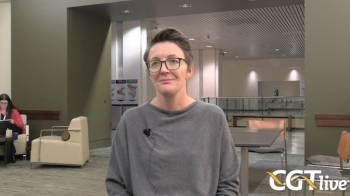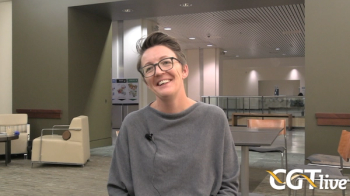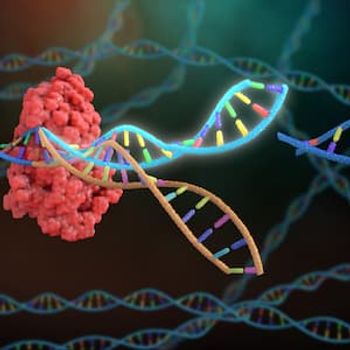
Commentary (Frank): Gene Therapy for Head and Neck Cancers
Lamont et al have presented a very clear and concise review of current gene therapy strategies in the management of squamous cell carcinoma of the head and neck. While the presentation highlighted the most important work to date in this expanding field, it also made reference to some controversies and challenges that we are now facing. With this in mind, I would like to expand on and clarify several points raised by the authors.
Lamont et al have presented a very clear and concise review of current gene therapy strategies in the management of squamous cell carcinoma of the head and neck. While the presentation highlighted the most important work to date in this expanding field, it also made reference to some controversies and challenges that we are now facing. With this in mind, I would like to expand on and clarify several points raised by the authors.
Gene Therapy as Part of First-Line Treatment
Over the past decade, the paradigm for the management of locally advanced squamous cell carcinoma of the head and neck has shifted at many major centers that treat a large number of these patients. As the authors point out, the standard of care has traditionally been surgery followed by postoperative external-beam radiation therapy (EBRT). Such therapies often result in the sacrifice of important organs of speech and deglutition.
That said, treatment strategies have been developed that are aimed at organ preservation in locally advanced cases of squamous cell carcinoma of the upper aerodigestive tract. These strategies often employ altered-fractionation radiation therapy or EBRT in various combinations with chemotherapy or brachytherapy. A substantial body of evidence suggests that such treatment modalities do not significantly compromise locoregional control of disease at various upper aerodigestive tract subsites, while physically preserving the organs of deglutition and speech in many patients.[1-4] How well these "preserved" organs function, however, has not clearly been determined by prospective evaluations of quality of life in this management setting.
The advent of organ preservation approaches for the management of locally advanced squamous cell carcinoma of the head and neck may afford the application of gene therapy strategies as part of first-line treatment. Accumulating evidence suggests that wild-type p53 tumor-suppressor gene therapy sensitizes squamous cell carcinoma of the head and neck to EBRT as well as chemotherapy, as shown in preclinical studies.[5,6] Administration of wild-type p53 at the time of, or just prior to, chemotherapy/EBRT could enhance local as well as regional disease control in patients who are enrolled in organ-preservation protocols.
However, this treatment strategy need not necessarily be limited to patients with advanced disease. A role for wild-type p53 gene replacement is also suggested in the management of early disease that could be managed with EBRT alone. Chemoprevention of high-risk premalignancies, as well as second primary tumors, may be other future applications of wild-type p53 gene transfer.
Vector Targeting in Gene Therapy
One of the great challenges facing gene therapy is vector targeting to the malignancy of interest. Poor vector tropism for tumors, as well as the nonspecific introduction of therapeutic genes into normal cells, remain formidable obstacles in the development of gene therapy. With this in mind, progress has been made in targeting cationic liposomal vectors to tumor cells.[5,7] A tumor-specific ligand (either folate or transferrin) has been placed on the surface of cationic liposomes containing wild-type p53 DNA, thus creating a ligand-directed liposomal gene-transfer tool.
Such vectors have shown efficacy in the systemic administration of animal tumor models. For relatively nontoxic vectors, such as cationic liposomes, the concept of systemic administration for metastatic disease management is made plausible by ligand targeting. It is for this reason that ligand-directed liposomes may become as highly valued a gene transfer tool as the current array of viral vectors.
ONYX-015 Selectivity in Cancer Gene Therapy
The attenuated adenovirus ONYX-015, which does not carry a therapeutic gene, offers potential in the management of squamous cell carcinoma of the head and neck. Much of the initial excitement over this vector stemmed from its apparent ability to selectively replicate in and kill p53 mutant cells, as the authors point out. This was thought to be a function of the fact that the viral genome is deleted at the early E1B-55kD locus.
Accumulating evidence, however, suggests that ONYX-015 can replicate in and kill p53 wild-type cells,[8,9] thus limiting its selectivity in the treatment setting. Furthermore, roughly only half of head and neck cancers are mutant at the p53 locus. Thus, if a mutant p53 genotype is the main criterion by which the antitumor effects of ONYX-015 are determined in cancer cells, then nearly half of all head and neck tumors would not be impacted by this vector.
Implications of the Bystander Effect in Gene Therapy
As the authors point out, the bystander effect is one of the interesting aspects of herpes simplex virus-thymidine kinase (HSV-tk) gene therapy, regardless of the utilized delivery vector. Cancer cells that have not received the gene (HSV-tk) that encodes the protein capable of phosphorylating the prodrug ganciclovir (Cytovene) nonetheless undergo apoptotic cell death.
Extensive research into this phenomenon has indicated that gap-junctional intercellular communication (GJIC) between adjoining cancer cells (typically epithelial malignancies) is responsible for this effect. Phosphorylated ganciclovir (the active cytotoxic agent), which is formed in HSV-tk transduced cells, is able to travel through gap-junction intercellular channels to adjoining cells that were not transduced.[10]
On the surface, it therefore seems that HSV-tk gene therapy would be highly efficient in squamous cell carcinoma of the head and neck. However, some loss of the GJIC phenotype seems to be a characteristic of the malignant phenotype of epithelial tumors in general.[10] One way to circumvent a diminished GJIC phenotype is to upregulate gap-junction production in a tumor prior to beginning HSV-tk gene therapy.
Many substances that are capable of doing this have been studied.[10] One of the most promising is all-trans-retinoic acid, which exerts its effect at the transcriptional level. All-trans-retinoic acid upregulates connexins, which are the protein subunits of gap-junction channels. All-trans-retinoic acid has been shown to enhance the efficacy of HSV-tk gene therapy in model systems through upregulation of GJIC. This may prove to be a valuable tool in squamous cell carcinoma of the head and neck, not only from a gene therapy point of view, but also because of the potential therapeutic effect that retinoids may exert on epithelial cancers by themselves.
Conclusions
In closing, it should be pointed out that the bystander effect in cancer gene therapy is not limited to HSV-tk gene transfer. There is accumulating evidence of the antiangiogenic effects of wild-type p53 gene transfer in vivo.[11] Nontransduced tumor bystander cells theoretically die from a depletion of a nutrient blood supply. Given the key role that angiogenesis appears to play in the malignant phenotype of solid tumors, wild-type p53 gene transfer, combined with other antiangiogenic molecular interventions, may prove to be novel additions to the treatment of squamous cell carcinoma of the head and neck under various circumstances.
Financial Disclosure:The author has no significant financial interest or other relationship with the manufacturers of any products or providers of any service mentioned in this article.
References:
1. Harrison LB, Lee HJ, Pfister DG, et al: Long-term results ofprimary radiotherapy with/without neck dissection for squamous cell cancer ofthe base of tongue. Head Neck 20:668-673, 1998.
2. Kies MS, Haraf DJ, Athanasiadis I, et al: Inductionchemotherapy followed by concurrent chemoradiation for advanced head and neckcancer: Improved disease control and survival. J Clin Oncol 16:2715-2721, 1998.
3. Lefebvre JL, Chevalier D, Luboinski B, et al: Larynxpreservation in pyriform sinus cancer: Preliminary results of a Europeanorganization for research and treatment of cancer phase III trial. J Natl CancerInst 88:890-899, 1996.
4. The Department of Veterans Affairs Laryngeal Cancer StudyGroup: Induction chemotherapy plus radiation compared with surgery plusradiation in patients with advanced laryngeal cancer. N Engl J Med324:1685-1690, 1991.
5. Xu L, Tang WH, Pirollo KF, et al: Chemosensitization of tumorcells by systemically delivered, ligand-directed, cationic liposome mediatedwtp53 gene therapy (abstract). Proceedings of the AACR-NCI-EORTC InternationalConference of Molecular Targets and Cancer Therapeutics 535, 1999.
6. Xu L, Pirollo KF, Chang EH: Transferrin-liposome-mediated p53sensitization of squamous cell carcinoma of the head and neck to radiation invitro. Hum Gene Ther 8:467-475, 1997.
7. Xu L, Chang EH: Tumor-targeted gene delivery by ligand-PEG"post-coated" cationic liposomes (abstract). Proceedings of theAACR-NCI-EORTC International Conference of Molecular Targets and CancerTherapeutics 502, 1999.
8. Goodrum FD, Ornelles DA: p53 status does not determineoutcome of E1B 55-kilodalton mutant adenovirus lytic infection. J Virol72:9479-9490, 1998.
9. Rothmann T, Hengstermann A, Whitaker NJ, et al: Replicationof ONYX-015, a potential anticancer adenovirus, is independent of p53 status intumor cells. J Virol 72:9470-9478, 1998.
10. Mesnil M, Yamasaki H: Bystander effect in herpes simplexvirus-thymidine kinase/ganciclovir cancer gene therapy: Role of gap-junctionalintercellular communication. Cancer Res 60:3989-3999, 2000.
11. Nishizaki M, Fujiwara T, Tanida T, et al: Recombinantadenovirus expressing wild-type p53 is antiangiogenic: A proposed mechanism forbystander effect. Clin Cancer Res 5:1015-1023, 1999.
Newsletter
Stay at the forefront of cutting-edge science with CGT—your direct line to expert insights, breakthrough data, and real-time coverage of the latest advancements in cell and gene therapy.










































